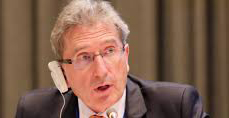Construction21 challenges developers around the world

Construction21, in partnership with CIRIDD and Ecole des Mines Saint Etienne, is launching a challenge within the framework of the Unite Ideas program of the United Nations. The goal? To realize its transformation into an even more user-friendly platform, adapted to its users and their uses. Christian Brodhag, President of Construction21, explains the ins and outs of this "challenge".
What is the Unite Ideas program of the United Nations?
Christian Brodhag: In 2015, the United Nations decided to launch, on the initiative of the Bureau of Informatics and Communications, a competition to appeal to the energies and creativity of said "open source" computer scientists. They are a global community, able to solve a number of public interest challenges, such as those of the United Nations, through open source software solutions. Each year, a new series of Unite Ideas challenges is launched and the developers respond to it, in groups or separately.
What is the connection between Unite Ideas and sustainable development?
C.B.: One of the major projects of the UN focuses on technological facilitation around the 17 Sustainable Development Goals (SDGs) or how science, technology and innovation (STI) can serve these objectives. Political coordination between States has been put in place through an annual forum and coordination between UN agencies and their information systems - there are more than twenty different today. But to trigger and sustain international mobilization and knowledge-sharing, the UN is considering developing an online platform.
Construction21 is positioned as one of the operational platforms responding to SDG11 "Making cities and human settlements inclusive, safe, resilient and sustainable", and wants to interface with the future online platform of the United Nations. From this point of view, the UN is very interested in seeing Construction21 - a network both local and global, with a multilingual interface - participating in the Unite Ideas challenge. The open source platform that will be developed can be used for other SDGs.
What kind of challenge does Construction21 bring to developers?
C.B.: We offer developers the opportunity to participate in the next evolution of Construction21 by working on a new data architecture. It is a question of introducing more flexibility, so that the platform can constantly adapt to the needs and the uses of its users. Today's web is no longer the one of 2010, when the first Construction21 prototype was created. Since then, social networks have evolved at great speed. Even though Construction21 has adapted and keeps offering new features, we believe it's time for a more radical change that also anticipates future developments.
By working on the architecture of the data on Construction21, the candidate teams will have to propose a prototype of a unique and interface that adapts to the user, directly providing them with the information they're inteerested in, according to their set parameters. Developers will also need to deliver a new unified and more flexible version of the building database.
The winners of this challenge will be selected to work with Construction21, CIRIDD and Ecole des Mines de Saint Etienne, to develop the new version of Construction21.
What do you mean by unique and personalized interface?
C.B.: Imagine a Construction21 that only delivers information matching your interests on your preferences. An interface that displays articles, case studies, or community content from the countries you follow. A French professional interested in the topic of biodiversity and who follows the Belgian, French, Luxembourg, Moroccan and international platforms, will find all the articles of the moment on the subject in only one place rather than going from a platform to the other.
By creating this unique and personalized interface, we want to introduce more cross-border communication and information and to facilitate more exchanges between professionals from different countries so they can learn from each other.
Hence the work on the building database?
C.B.: Absolutely. This database is a wealth of information on best practices and innovations implemented in buildings: in France, Belgium, Spain, Italy, Germany, China, Luxembourg, Morocco, Algeria, in Romania, Lithuania and well beyond. Its future version must allow users to travel from one country to another to draw ideas and apply them at home, to question their local models and also to encourage them to share their experiences.
We also want them to be able to display the case studies in relation to the solutions implemented and to facilitate the comparison between achievements of different countries. This reshuffle is also intended to be declined on the two other databases of Construction21: neighborhoods and infrastructures.
What is the schedule for this challenge?
C.B.: The challenge was launched on the 31st of January and the teams have to be gathered during February to start their developments at the end of the month. They have until the beginning of May to deliver their work which will be judged by a jury in which will participate the United Nations, Construction21, the CIRIDD and Ecole des Mines of Saint Etienne. We will announce the winners in June at the UN headquarters in New York at the STI forum. It is with them that the new platform will be developed. So we invite them to visit the challenge platform: https://ideas.unite.un.org.
Interviewed by Sylvain Bosquet for Construction21



